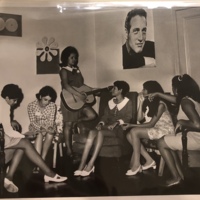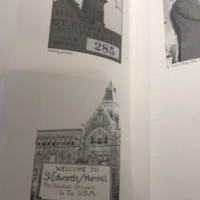Historiography
When taking into consideration the attainment of education by women since the colonial period, women have never been closer to gender equality. In 2019, women made up 58.2 percent of college campuses, a relatively large jump from 38.7 percent in 1965, and an even larger increase from 29 percent in 1947. [2] And yet, women were largely excluded from higher education until very recently. Many factors contributed to why women made up a small population on college campuses, the biggest reason stems from social anxieties of women being away from their homes who were instead seeking an education.
Between the eighteenth and nineteenth century, it was frowned upon to allow women into traditional - meaning traditionally male - college and universities. In fact, it was a common belief that women and girls were intellectually inferior to men. Women were encouraged to learn skills about maintaining a home, while men were taught how to maintain a business or financially support a household. [3] In the event that women were educated in higher learning, they were taught in academies or seminaries - often being taught languages, science, and history in hopes of preparing the women into teaching careers. In the twentieth century, however, women were slowly being integrated into college campuses, but they did not experience the same liberties men did.
Many colleges and universities opened doors to men long before women were even presented with an opportunity to learn in a classroom with men. Yet coeducational colleges were the first opportunities women had to attend school alongside men. Eventually, men and women were allowed on campus together, but they were in no way equal. On any given campus, while male students definitely got in trouble for breaking a conduct policy, no male student faced the restrictions that female students faced. These restrictions were almost always promolgated with the averred intent of protecting the reputation of the young ladies, but these women were also limited in exploring their educational and vocational opportunities because of selected curriculum for co-educational programs.
St. Edward’s was not entirely different from most other schools that enrolled both men and women at the time. For starters, the administration at St. Edward’s were hesitant about completely adopting a coeducational program; instead President Raymond Fleck proposed the adoption of a co-ordinate college, In this model, the small liberal arts university would host separate colleges for men and women, each equipped with different curriculum programs and social expectations, but the two schools would share the same campus. Discussion about this coordinate program began in 1964 when Brother Fleck contacted the Sister Servants of the Immaculate Heart of Mary. Immediately discussions ensued about the need for a Catholic woman’s college in Texas and the potential numbers associated with funding and student enrollment, as well as the roles of the sisters as administrators.
The fours years in which Maryhill College was active were very reflective of the education of women in Texas at that time. In the following exhibit, it will become evident in the ways in which women were affected by curriculum in the coordinate program, as well as how women were treated by their male counterparts.
![[Maryhill/St. Edward's Brochure] [Maryhill/St. Edward's Brochure]](http://s3.amazonaws.com/archives-omeka-glen/square_thumbnails/8bb6dacfbb4b83995600b52e8fbef128.jpg)


![[Drawing of a Maryhill Student] [Drawing of a Maryhill Student]](http://s3.amazonaws.com/archives-omeka-glen/square_thumbnails/3faa764f749214de31529e974f276d26.jpg)